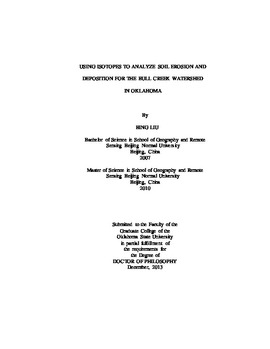| dc.contributor.advisor | Storm, Daniel E. | |
| dc.contributor.author | Liu, Bing | |
| dc.date.accessioned | 2015-06-17T20:06:47Z | |
| dc.date.available | 2015-06-17T20:06:47Z | |
| dc.date.issued | 2013-12 | |
| dc.identifier.uri | https://hdl.handle.net/11244/14973 | |
| dc.description.abstract | Soil erosion is a serious environmental problem worldwide. Extensive research has been conducted identifying and quantifying erosion processes, measuring soil erosion, and evaluating the effectiveness of soil conservation practices. Accurately predicting soil erosion in space and time continues to be a challenge, and detailed spatial erosion data at field and watershed scales are needed to validate, calibrate, and improve erosion models. The Cs-137 and fingerprinting methods have been used to estimate soil erosion and sediment sources in many studies, but uncertainties exist in both methods. The purpose of this study was to evaluate these two methods and compare predictions with the Water Erosion Prediction Project (WEPP) model. The study area for this research was the Bull Creek watershed, located in west central Oklahoma. The Cs-137 method predicted reasonable long-term average soil erosion and deposition rates and integrated spatial and temporal changes in erosion/deposition. Compared to WEPP, the Cs-137 method needed less information and only required a one-time sampling. The fingerprinting method provided useful information about the sediment source contributions and performed best with two sources. For the Bull Creek study area, the mixing model predicted the source contribution with the lowest model errors; however, the results were not significantly different. The new Discriminate Function Analysis method may be a better method since it avoids spurious numerical solutions. When using the Cs-137 and the fingerprinting methods, sample collection and the proper application of particle size correction factors were critical. When there were two source types, the fingerprinting method and WEPP watershed model predicted similar source contributions. However, with three source types their predictions diverged. In addition, WEPP predicted significantly less sediment yield from the rangeland compared to the fingerprinting method. Combining erosion models with the fingerprinting method provides a more detailed evaluation of erosion predictions, which may result in improved land management recommendations and decisions. | |
| dc.format | application/pdf | |
| dc.language | en_US | |
| dc.rights | Copyright is held by the author who has granted the Oklahoma State University Library the non-exclusive right to share this material in its institutional repository. Contact Digital Library Services at lib-dls@okstate.edu or 405-744-9161 for the permission policy on the use, reproduction or distribution of this material. | |
| dc.title | Using isotopes to analyze soil erosion and deposition for the Bull Creek watershed in Oklahoma | |
| dc.contributor.committeeMember | Brown, Glenn O. | |
| dc.contributor.committeeMember | Warren, Jason G. | |
| dc.contributor.committeeMember | Zou, Chris Bocai | |
| osu.filename | Liu_okstate_0664D_13182.pdf | |
| osu.accesstype | Open Access | |
| dc.type.genre | Dissertation | |
| dc.type.material | Text | |
| dc.subject.keywords | cs-137 method | |
| dc.subject.keywords | discriminant function analysis method | |
| dc.subject.keywords | fingerprinting method | |
| dc.subject.keywords | soil erosion | |
| dc.subject.keywords | watershed scale | |
| thesis.degree.discipline | Environmental Science | |
| thesis.degree.grantor | Oklahoma State University | |
